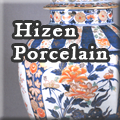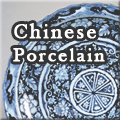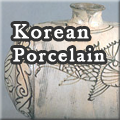Major Pieces From The Museum Collection
The Museum collection focuses mainly on Oriental porcelain, specifically Japanese, Chinese and Korean porcelains. Japanese porcelain is what is known as Hizen porcelain, produced in the Hizen region (modern day Saga and Nagasaki Prefectures) before the early Edo period (1608-1868).
The Museum collection focuses mainly on Oriental porcelain, specifically Japanese, Chinese and Korean porcelains. Japanese porcelain is what is known as Hizen porcelain, produced in the Hizen region (modern day Saga and Nagasaki Prefectures) before the early Edo period (1608-1868).
Imari ware
The Japanese first started to produce porcelain in the Arita region of Saga Prefecture in the 1610s. It was shipped throughout Japan and abroad from the port of Imari, and it was this association that resulted in it coming to be known as Imari ware.
Shoki Imari, or Early Imari, ware (Early 17th century)
Dish, decorated with landscape and pavilion design in underglaze blue. Imari ware. Edo period. 17th century.
Works made in the early 17th century are called shoki Imari, in reference to the early stages of Imari ware. The main decorative techniques used during this period were underglaze cobalt blue and white, celadon glaze, iron glaze, and lapis lazuli blue glaze. The wares included not only items for daily use such as dishes, cups and bottles, but also utensils for the tea ceremony. Produced by pottery makers who had yet to fully master porcelain-making techniques, early Imari porcelains are characterized by their uneven tones of cobalt blue, slightly warped forms, and even the occasional fingerprint, but it is this very lack of refinement that imbues them with their interesting and charming naivete and sense of warmth.
Works made in the early 17th century are called shoki Imari, in reference to the early stages of Imari ware. The main decorative techniques used during this period were underglaze cobalt blue and white, celadon glaze, iron glaze, and lapis lazuli blue glaze. The wares included not only items for daily use such as dishes, cups and bottles, but also utensils for the tea ceremony. Produced by pottery makers who had yet to fully master porcelain-making techniques, early Imari porcelains are characterized by their uneven tones of cobalt blue, slightly warped forms, and even the occasional fingerprint, but it is this very lack of refinement that imbues them with their interesting and charming naivete and sense of warmth.
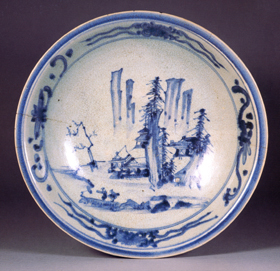
Dish, decorated with landscape and pavilion design in underglaze blue. Imari ware. Edo period. Early 17th century.
The dish has steep curve around, which connects the large mouth with blue underglazed brim and the small base, and the size of the base is small than it of one-third of the mouth. The inside of the dish is divided into two canvases. On the one at the bottom, a tall castle is drawn in a landscape of mountains and water's edge exquisitely,and flower design is on the above. Uwayuu(overglazing liquid), slightly colored in blue, and tiny crack on the surface creates a depth in the drawing and misty atmosphere. It is attribute to a product of the Hyakken kiln, a well-known kiln during the early stage of Imari porcelain. No design on the back.
The dish has steep curve around, which connects the large mouth with blue underglazed brim and the small base, and the size of the base is small than it of one-third of the mouth. The inside of the dish is divided into two canvases. On the one at the bottom, a tall castle is drawn in a landscape of mountains and water's edge exquisitely,and flower design is on the above. Uwayuu(overglazing liquid), slightly colored in blue, and tiny crack on the surface creates a depth in the drawing and misty atmosphere. It is attribute to a product of the Hyakken kiln, a well-known kiln during the early stage of Imari porcelain. No design on the back.
Ko-Kutani Style (Mid 17th century)
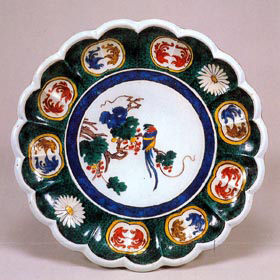
Dish with foliated rim, decorated with a bird and grapevine design in overglaze enamels, the underside with a character mark within a double square in underglaze blue. Imari ware in the Ko-Kutani style. Edo period. Mid 17th century.
Within less than half a century after the emergence of Japanese porcelain, ceramicists had developed the decorative technique of coloring with overglaze enamels, commonly using red, green and yellow. This colored porcelain is known as iro-e, and the early iro-e made in the mid 17th century is referred to as the Ko-Kutani style. The varieties of Ko-Kutani ware were wide-ranging and included shonzui-de, which involved decorating pieces with colorful Chinese-style geometric patterns; gosai-de, which involved the application of uniquely Japanese designs that borrowed heavily from Chinese painting; and ao-de, a style with an overwhelming presence that entailed filling the entire surface of each piece with yellow and green.
Within less than half a century after the emergence of Japanese porcelain, ceramicists had developed the decorative technique of coloring with overglaze enamels, commonly using red, green and yellow. This colored porcelain is known as iro-e, and the early iro-e made in the mid 17th century is referred to as the Ko-Kutani style. The varieties of Ko-Kutani ware were wide-ranging and included shonzui-de, which involved decorating pieces with colorful Chinese-style geometric patterns; gosai-de, which involved the application of uniquely Japanese designs that borrowed heavily from Chinese painting; and ao-de, a style with an overwhelming presence that entailed filling the entire surface of each piece with yellow and green.
Kakiemon style (The second half of the 17th century)
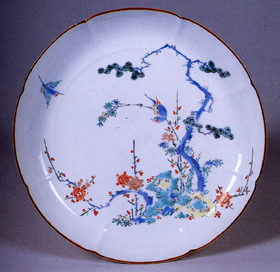
Dish with foliated rim, decorated with flower and bird design in overglaze enamels. Imari ware in Kakiemon style. Edo period. Second half of the 17th century.
Imari ware began to be exported in earnest around the second half of the 17th century, and the Kakiemon style was typical of the Imari ware produced for export at the time. The red applied over the milk-white porcelain base known as nigoshide is almost vermillion, with brightly colored uwa-etsuke (overglaze enamels) a feature of the style. The designs, which are pictorial in style, include flowers and birds or landscapes and figures painted with large amounts of negative space. Kakiemon ware includes vessels such as bowls and vases as well as figures and other modeled forms.
Imari ware began to be exported in earnest around the second half of the 17th century, and the Kakiemon style was typical of the Imari ware produced for export at the time. The red applied over the milk-white porcelain base known as nigoshide is almost vermillion, with brightly colored uwa-etsuke (overglaze enamels) a feature of the style. The designs, which are pictorial in style, include flowers and birds or landscapes and figures painted with large amounts of negative space. Kakiemon ware includes vessels such as bowls and vases as well as figures and other modeled forms.
Kinrande style (Late 17th to early 18th century)
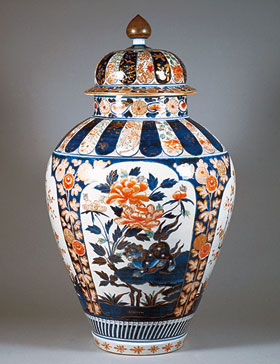
High-shouldered jar with domed cover and simple knob, decorated with shishi lion under peonies, plums and chrysanthemums in underglaze blue, overglaze enamels and gold. Imari ware. Edo period. Late17th century.
The second half of the 17th century coincided with a period of upheaval in China as the Ming dynasty gave way to the Ching dynasty, and Chinese ceramic production declined as a result. Consequently, the Dutch East India Company set its sites on the Arita region of Japan as an alternative center of porcelain production. This led to Imari ware being produced in large volumes, with the Kakiemon style giving way in the 1690s to the emergence of blue-and-white sometsuke, polychrome iro-e, and gold-brocade kinrande ware. Most kinrande ware is broadly classified into pieces destined for the domestic market and pieces destined for the European market. These vessels, which are covered in colorful designs and feature the abundant use of gold, have a strong presence characterized by exuberance and depth.
The second half of the 17th century coincided with a period of upheaval in China as the Ming dynasty gave way to the Ching dynasty, and Chinese ceramic production declined as a result. Consequently, the Dutch East India Company set its sites on the Arita region of Japan as an alternative center of porcelain production. This led to Imari ware being produced in large volumes, with the Kakiemon style giving way in the 1690s to the emergence of blue-and-white sometsuke, polychrome iro-e, and gold-brocade kinrande ware. Most kinrande ware is broadly classified into pieces destined for the domestic market and pieces destined for the European market. These vessels, which are covered in colorful designs and feature the abundant use of gold, have a strong presence characterized by exuberance and depth.
Nabeshima ware
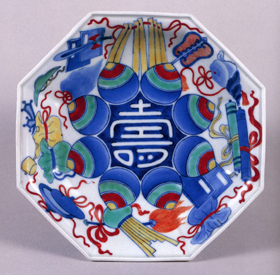
Octagonal dish, decorated with design of treasures around the character "kotobuki" (felicitations) in underglaze blue and overglaze enamels. Nabeshima ware. Edo period. Late 17th to early 18th century.
Nabeshima ware is the term used to describe porcelain produced early in the Edo period by the Nabeshima clan, rulers of Japan's only porcelain producing area, by rounding up the most talented ceramicists from in and around the town of Arita in present-day Saga prefecture and putting them to work in kilns in Okawachiyama. Unlike Imari ware, which was produced for the domestic and overseas markets, Nabeshima ware was produced using the finest materials and in accordance with the best techniques as gifts for the shogun, senior government officials, and other dignitaries. The mokuhai-gata dishes are in standardized sizes of five sun (approx. 15 cm), seven sun (approx. 20 cm), and a shaku (approx. 30 cm), and are adorned with delicate sometsuke, red, yellow, and green patterns applied using overglaze enamels.
Nabeshima ware is the term used to describe porcelain produced early in the Edo period by the Nabeshima clan, rulers of Japan's only porcelain producing area, by rounding up the most talented ceramicists from in and around the town of Arita in present-day Saga prefecture and putting them to work in kilns in Okawachiyama. Unlike Imari ware, which was produced for the domestic and overseas markets, Nabeshima ware was produced using the finest materials and in accordance with the best techniques as gifts for the shogun, senior government officials, and other dignitaries. The mokuhai-gata dishes are in standardized sizes of five sun (approx. 15 cm), seven sun (approx. 20 cm), and a shaku (approx. 30 cm), and are adorned with delicate sometsuke, red, yellow, and green patterns applied using overglaze enamels.
The museum has collection of Chinese porcelain produced between BC and the Qingd (1644-1911)The styles of these porcelains the tastes of the emperorschronological change in our collection.
Tang dynasty (618-907)
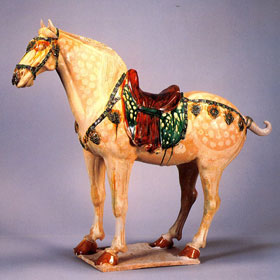
Pottery figure of a saddled horse, decorated in tricolor glaze. Tang dynasty. 8th century
nglazed earthenware around 5000 BC, and constantly refin their techniques over the . The green glaze pottery of the Han dynasty became popular as burial accessories, and in the later Tang dynasty, gorgeous tricolor pottery and smooth, high-quality white porcelain produced in vast quantities.tradeTang dynasty porcelainexotic.
nglazed earthenware around 5000 BC, and constantly refin their techniques over the . The green glaze pottery of the Han dynasty became popular as burial accessories, and in the later Tang dynasty, gorgeous tricolor pottery and smooth, high-quality white porcelain produced in vast quantities.tradeTang dynasty porcelainexotic.
Song dynasty (960-1279)
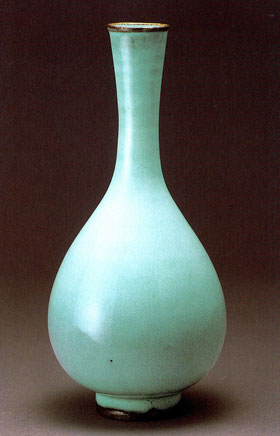
Pear-shaped vase, covered with opaque bluish glaze. Chun ware. Northern Song dynasty. 12th century.
The Song dynasty is celebrated as the golden age of Chinese ceramics. Masterpieces of celadon and white porcelain were produced in Northern and Southern China, and were transported abroad. Prime examples include Yaozhou ware celadon, Ding ware white porcelain, and tianmu tea bowls from the Cizhou kiln. The Japanese literati valued “So-ji”, or Song dynasty porcelains, for the aesthetic sensibilities and deep spirituality they embodied.
The Song dynasty is celebrated as the golden age of Chinese ceramics. Masterpieces of celadon and white porcelain were produced in Northern and Southern China, and were transported abroad. Prime examples include Yaozhou ware celadon, Ding ware white porcelain, and tianmu tea bowls from the Cizhou kiln. The Japanese literati valued “So-ji”, or Song dynasty porcelains, for the aesthetic sensibilities and deep spirituality they embodied.
Yuan dynasty (1206-1368)
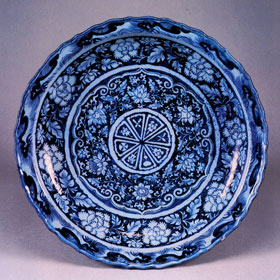
Dish, decorated with rocks and flowering plants in the center in underglaze blue. Jingdezhen ware. Ming dynasty. First half of the 15th century.
It was in the Yuan dynasty that blue-and-white qinghua ware (known as sometsuke in Japan) became popular in China. Qinghua ware, which was made by painting designs with cobalt oxide paint and applying a coat of transparent glaze over the top before firing, was an important discovery that formed the basis for the production of the magnificent porcelain of the later Ming and Qing dynasties. Jingdezhen, where this technique was developed, secured a position as one of China's major porcelain-producing areas. Many magnificent masterpieces were produced at the kilns in Jingdezhen by painting elaborate patterns in blue-and-white, underglaze red, and other colors on large plates, bottles, and other vessels. The imposing form and detailed decoration of these pieces give them a powerful and dignified presence.
It was in the Yuan dynasty that blue-and-white qinghua ware (known as sometsuke in Japan) became popular in China. Qinghua ware, which was made by painting designs with cobalt oxide paint and applying a coat of transparent glaze over the top before firing, was an important discovery that formed the basis for the production of the magnificent porcelain of the later Ming and Qing dynasties. Jingdezhen, where this technique was developed, secured a position as one of China's major porcelain-producing areas. Many magnificent masterpieces were produced at the kilns in Jingdezhen by painting elaborate patterns in blue-and-white, underglaze red, and other colors on large plates, bottles, and other vessels. The imposing form and detailed decoration of these pieces give them a powerful and dignified presence.
Ming dynasty (1368-1644)
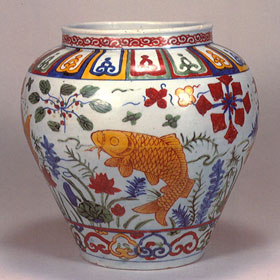
Jar, decorated with design of fishes among aquatic weeds in underglaze blue and overglaze enamels in wucai style. Jingdezhen ware. Ming dynasty. Jiajing mark and period.
The Ming dynasty saw Jingdezhen solidify its position as the center of porcelain production in China with the establishment in the area of imperial kilns producing porcelain for the Chinese imperial court. The blue-and-white technique developed in the Yuan dynasty was further refined. In the Jiajing period of the 16th century, porcelain featuring the wucai "five-color" decoration was also produced in large numbers, while early overglaze enamel, gold-brocade, and other colorful wares were also developed and produced en masse at both imperial kilns and general kilns that supplied porcelain to the general population.
The Ming dynasty saw Jingdezhen solidify its position as the center of porcelain production in China with the establishment in the area of imperial kilns producing porcelain for the Chinese imperial court. The blue-and-white technique developed in the Yuan dynasty was further refined. In the Jiajing period of the 16th century, porcelain featuring the wucai "five-color" decoration was also produced in large numbers, while early overglaze enamel, gold-brocade, and other colorful wares were also developed and produced en masse at both imperial kilns and general kilns that supplied porcelain to the general population.
Qing dynasty (1644-1911)
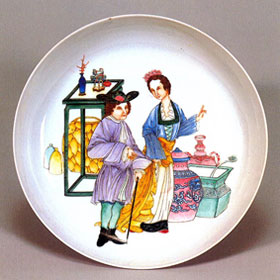
Dish, decorated with Western figures design in famille rose enamels. Jingdezhen ware. Qing dynasty. Yong-zheng mark and period.
From the end of the Ming dynasty through to the start of the Qing dynasty, new styles of porcelain intended for export such as the wanli, old enameled porcelain, and old blue-and-white styles emerged. In the Qing dynasty, the fencai "powdered colors" technique was developed, while the doucai enameling technique, which was developed in the Ming dynasty, was further refined in the Yongzheng period, leading some to describe the highly elaborate porcelain of the Qing dynasty as "fully refined technical expertise and artistry." The works display the unique beauty of the style of the Qing dynasty, a beauty achieved through the free use of these and other techniques such as peach bloom and tea dust glazing.
From the end of the Ming dynasty through to the start of the Qing dynasty, new styles of porcelain intended for export such as the wanli, old enameled porcelain, and old blue-and-white styles emerged. In the Qing dynasty, the fencai "powdered colors" technique was developed, while the doucai enameling technique, which was developed in the Ming dynasty, was further refined in the Yongzheng period, leading some to describe the highly elaborate porcelain of the Qing dynasty as "fully refined technical expertise and artistry." The works display the unique beauty of the style of the Qing dynasty, a beauty achieved through the free use of these and other techniques such as peach bloom and tea dust glazing.
Between 1592 and 1598 of Japan's Warring States period, Nabeshima Naoshige, the lord of Hizen, was sent on Toyotomi Hideyoshi's campaigns to Korea to Korea, where he became acquainted with fine ceramicists, whom he brought back to settle in Japan. It was one of these Korean ceramicists, Yi Sam-pyong, who went on to successfully produce Japan's first porcelain.
Koryo dynasty (918-1392)
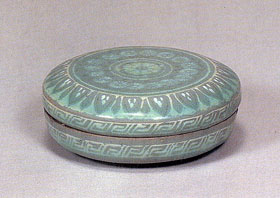
Celadon box and cover, decorated with inlaid chrysanthemum and lotus petals. Koryo dynasty. 12th-13th century.
Porcelain in the form of mainly celadon ware began to be produced on the Korean peninsula under Chinese influence sometime between the late-9th and 10th centuries. The most notable ceramic ware of the Koryo period, Koryo celadon continued to develop as decorative techniques were refined, and in the 12th and 13th centuries, when the form reached its zenith, countless fine examples of inlaid celadon and other refined celadon ware were produced.
Porcelain in the form of mainly celadon ware began to be produced on the Korean peninsula under Chinese influence sometime between the late-9th and 10th centuries. The most notable ceramic ware of the Koryo period, Koryo celadon continued to develop as decorative techniques were refined, and in the 12th and 13th centuries, when the form reached its zenith, countless fine examples of inlaid celadon and other refined celadon ware were produced.
Yi dynasty (1392-1910)
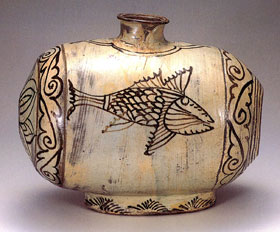
Bottle in shape of rice bale, decorated with fish design in underglaze iron on white slip. Punch’ong ware. Yi dynasty. 15th-16th century.
In the 15th and 16th centuries, earthenware and porcelain in the tradition of the earlier Koryo celadon ware were both being produced side by side, as where some fine examples of Punch'ong ware, a form of stoneware covered in a light slip coating and adorned with various surface decorations beneath the final clear glaze. It was in this same period that white porcelain began to be produced in large quantities, and the development of underglaze blue painting and the painting of designs with an iron-rich clay mixture before glazing and firing, as well as of copper-red glazed porcelain, saw the emergence of some extremely refined items that made clever use of blank space. The Korean works have an atmospheric beauty that is in strong contrast to the almost perfect beauty of Chinese ceramic ware.
In the 15th and 16th centuries, earthenware and porcelain in the tradition of the earlier Koryo celadon ware were both being produced side by side, as where some fine examples of Punch'ong ware, a form of stoneware covered in a light slip coating and adorned with various surface decorations beneath the final clear glaze. It was in this same period that white porcelain began to be produced in large quantities, and the development of underglaze blue painting and the painting of designs with an iron-rich clay mixture before glazing and firing, as well as of copper-red glazed porcelain, saw the emergence of some extremely refined items that made clever use of blank space. The Korean works have an atmospheric beauty that is in strong contrast to the almost perfect beauty of Chinese ceramic ware.
.jpg)





